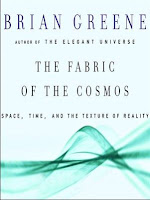The book I chose for my first blog post is one is called The Fabric of the Cosmos by Brian
Greene. I bought the book on my Kindle after watching the four-part special on
PBS a couple of years ago. Had I realized that the actual book was 592 pages
long, I would have chosen different material (a big dumb movie, perhaps?) for
my first blog post. Oh well. Instead, I will review it by chapter by chapter.
The author states in the preface
that the book “is intended primarily for
the general reader who has little or no formal training in the sciences but
whose desire to understand the worked of the universes provides incentive to
grapple with a number of complex and challenging concepts.
Students, teachers, and professionals
should also find much of interest in the book and much of what is covered in
the book is controversial.”
Although
Greene thinks he is writing to the general reader, it is more disposed towards
the college-aged. I had an easy time understanding the concepts presented when
done through television where Greene had the aid of producers and directors to
get his points across. Here though, when Greene is on his own, the material is
much harder to understand.
The first chapter is a quick history of physics. Greene begins
his tome with a quote from a book he read as a kid, The Myth of Sisyphus, by Albert Camus: “There is but one truly philosophical problem, and that is suicide.
Whether or not the world has three dimensions or the mind nine or twelve
categories comes afterward.” Questions like this were part of the game
humanity played and deserved attention only after this issue had been settled. Sisyphus was the guy who was forced to roll a boulder up a hill every day. The next day the boulder would be back at the bottom of the hill waiting for Sisyphus to start again. Camus likened his struggle with the absurd meaning of life. Great reading for a little kid, Greene.
Breakthroughs
in physics have forced, and continue to force the revisions to how we view the
cosmos. The reason for this book is to explain the most important of these
revisions and how they affect our perception of reality and our species’
long-term project to understand space and time.
After
Newton, his equations were developed into elaborate mathematical structures
that significantly extend their reach and utility. Scientists took his ideas
and ran with them.
Newton
hit a stumbling block while formulating the laws of motion. Is space a real
physical entity or is it an abstract idea humans use to comprehend the cosmos? He
decided that space and time real things that provided the universe with the
rigid and unchangeable scaffolding that gives the universe shape and structure.
This was dogma for the next two hundred years.
Then Einstein
realized that Newton’s conception of space and time was flawed. He wrote his
special and general theories of relativity in 1905 and 1915. A decade later,
he rewrote the laws of gravity.
Even
though Einstein rewrote the laws of the universe, Newtonian physics still
provide accurate and useful approximations though. For example, Newton’s and
Maxwell’s equations can tell you the positions and velocities of all objects at a particular moment.
In the
1930s, physicists were introduced to quantum mechanics, which were capable of
resolving a host of puzzles and explaining a variety of new data from the
atomic and subatomic realms.
Quantum Mechanics describes a reality in which things
sometimes hover in a haze of being partly on way and partly another and become
definite only when a suitable observation forces them to settle on a specific
outcome. Now I have a migraine.
Einstein
wrote a paper in 1935 with colleagues intending to attack quantum theory but it
ended up supporting it. Despite what we know, quantum mechanics and relativity
cannot yet explain why time travels in one direction, from the past towards the
future. Eggs break but don’t unbreak, candles melt but don’t unmelt, memories
are from the past, never the future. Quantum mechanics say that this should be
possible but we never see it.
Einstein
spent the last years of his life working on a unifying theory and many younger
scientists thought he was mad and went down the wrong path. Now scientists think he have been right all along.
The
writing is quite dry and well over my head. This was the exact opposite of the
four-part series I watched on PBS. As
the book progresses, things do get a little easier to understand. At least for
me. If you don't feel like reading the book, you can watch the four part series here:




No comments:
Post a Comment